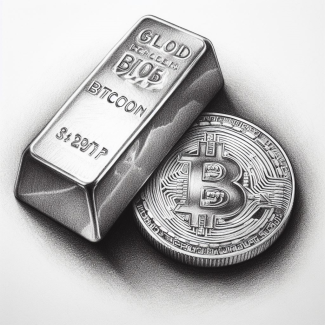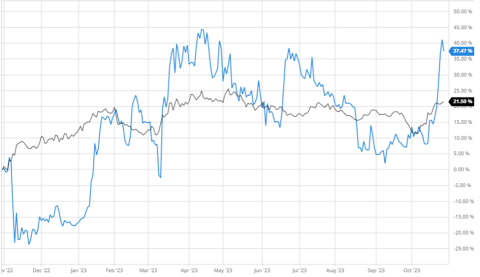
Bitcoin Digital Gold
Bitcoin has often been described as “digital gold.” It is an apt comparison in many ways. Both assets are mined: gold through physical extraction from the Earth and Bitcoin through a verification process of linked computers working together on the blockchain. Both have a finite supply that is diminished as more mining occurs. There will only ever be 21 million Bitcoin in existence, while all the gold contained in the Earth’s crust could eventually be fully extracted.
These two assets are not only similar to each other in a qualitative sense; they are also alike in a quantitative sense, at least when it comes to the returns that can be earned from investing in them. Both gold and Bitcoin are considered alternative investments, and as such, they are both highly volatile with a low correlation to traditional asset classes. If one of these assets is incorporated into an investment portfolio, it would add a layer of diversification that could not be obtained by including additional stocks or bonds.
The perceived similarities of gold and Bitcoin have led some to question whether the imminent launch of spot Bitcoin ETFs in the United States will negatively impact the demand for gold exposure within investment portfolios. Will investors sell their gold ETFs to buy Bitcoin ETFs? They may or may not, but the actual answer should be more nuanced than a simple yes or no. It all depends on an investor’s risk tolerance. While Bitcoin and gold are both volatile assets, Bitcoin’s volatility is nearly five times that of gold. This is illustrated in the chart below, showing returns over the last year of the ProShares Bitcoin Futures ETF (BITO) in blue vs. the abrdn Physical Gold ETF (SGOL) in black. Bitcoin has performed better than gold over the last year, but it took a very wild ride to get there.
This difference in volatility could prove beneficial, however, because it could lead the respective return streams of Bitcoin and gold to zig while the other zags, potentially providing even greater diversification to a portfolio than if only one of the two were included. This is borne out in the correlation data between gold, Bitcoin, and the S&P 500. Over the last five years, the correlation between Bitcoin and gold is 0.14, which is precisely the same as the correlation between gold and the S&P 500.
Gold has a market cap of nearly $13 trillion, and Bitcoin has an approximate market cap of only $600 billion. Even if the launch of a spot Bitcoin ETF somehow causes a flow of $1 trillion out of gold and into Bitcoin, it would only be about an 8% decrease in the total market cap of gold, while the market cap of Bitcoin would nearly triple. This leads us to believe that the gold ETF market will continue along just fine even if a spot BTC ETF can grow the market presence of Bitcoin well beyond what it occupies today.
Here at iSectors, we have been proponents of both Bitcoin and gold, offering outsourced ETF model portfolios with focused exposure to both asset classes (the iSectors CryptoBlock® Allocation and the iSectors® Precious Metals Allocation). We believe that gold and Bitcoin can coexist. It would be wise to consider allocating a small portion of an investment portfolio to some diversifying asset class, be that in Bitcoin, gold, some combination of the two, or another asset class such as commodities, other real assets, hedged strategies, etc.


